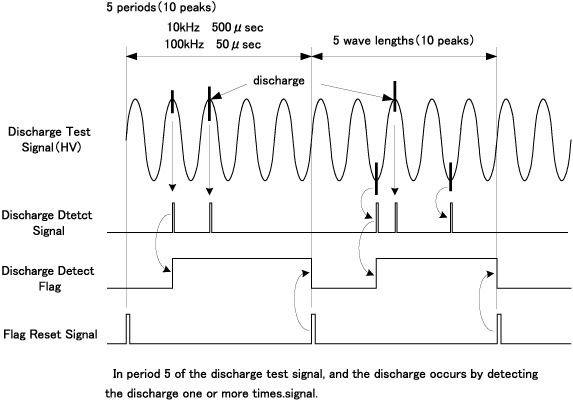Corona discharge tester
XT-350
PB39b

Overview
The XT-350 uses the corona discharge phenomenon to test the insulation of capacitors, motors, and other kinds of items, including the corona discharge withstand voltage between transformer winding wires and cores, within secondary winding wires, and between the primary and secondary sides.
XT-350 tests for the presence of corona discharges and flashovers of test objects by generating selectable voltages (0 to 10 kVrms, tuning is required) at selectable frequencies (10 k to 100 kHz) at the HV terminal and applying this to the test object.
Because you can accurately detect corona discharges that were previously difficult to detect, we believe that this tester will be useful improving your product reliability.
It is very dangerous if there is corona discharge in a high-voltage supply circuit. You can investigate this as well with the XT-350.
For example, it is now possible to carry out insulation testing that was previously impossible, such as for the corona discharge withstand voltage between connectors or high-voltage patterns of printed circuit boards and the chassis.
The high voltage current (HV Curr.) flowing in the load is shown on the display of the XT-350 so you can see the impedance of the test object. This is useful for estimating the state of deterioration during endurance testing and other testing.
We have prepared a tuning mechanism that enables you to change the impedance of the test circuit for the capacity load of high voltage capacitors and other test items.
Operation
Along with making light and sound, flashovers consume energy, so a product clearly operates poorly. However, corona discharges are generated by the ionization of air, and their pulse is faint. Therefore, a product may appear to operate normally, which makes corona discharge detection difficult.
However, the ozone (O3) that is created along with corona discharges has a strong oxidization power and can encourage degradation of insulation over the long term and includes the risk of creating flashovers. Therefore, it is desirable to take preventative measures for corona discharges.
The XT 350 checks for corona discharges and flashovers generated by high-voltage waveforms.
If a discharge is detected, the count is increased by one, and then displayed.
Corona DischargeDisplays 0 to 100%. Detect the corona discharge signal included in the electric current flowing in an examination object. (It is not indication of electric charge)
(There is explanation on page 32 about an electric discharge rate)
FlashoverDisplays 0 to 255. The count returns to 128 each time it reaches 255.
About Discharge rateDischarge Rate


specification
Corona discharge tester
XT-350 PB39b

- Test frequency
- 10 kHz to 100 kHz Selectable at 1 kHz steps
- Maximum test voltage
- 10 kVrms (Tuning minimizes drive current)
- Drive waveform
- Continuous sine wave
- Load range
- Capacitance load range: 350 to 1000 pF at 10 kHz;
Inductance load range 10 to 100 kHz; about 300 mH or more (involved in frequency) - Continuous test voltage
- Output voltage when a load is connected after tuning to the position where the drive current is smallest, and the power amp temperature is 95°C or lower
- Maximum HV current
- 1A (Continuous is 700 mA)
- Adjustment
- HV Adj. Sensitivity adjustment of HV Impedance tuning
- Drive output
- Auto (with Auto Corona search function) / Manual
- Drive Adj.
- Output voltage manual adjustment
- Tuning
- Minimize Drive Current in Manual mode.
- Measurement types
- High Voltage, Flashover, Corona, Drive Voltage, Drive Current, Wakeup Time, Real Time, HV Current
- Dimensions
- MainUnit: 430(W) x 470(D) x 180(H)mm [ Packing W510 x D580 x H270 mm ]
ProbeBox: 430(W) x 470(D) x 180(H)mm [ Packing W510 x D580 x H270 mm ] - Mass
- MainUnit: Approx. 16kg G/Weight 21kgs
ProbeBox: Approx. 13kg G/Weight 17kgs - Power consumption
- 800 VA
